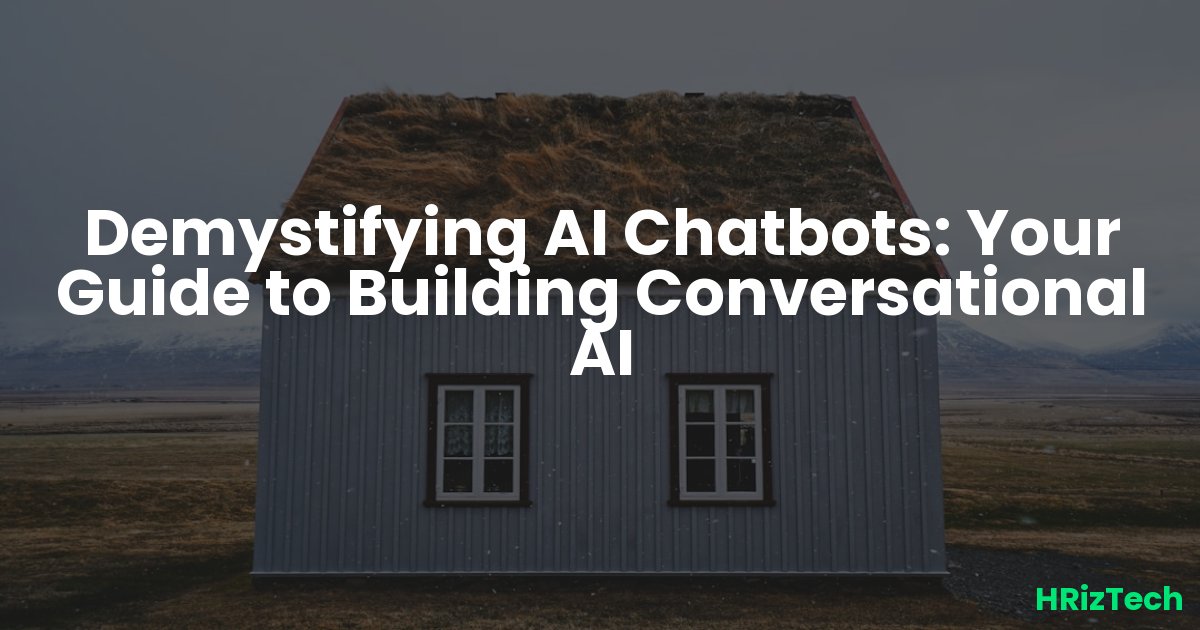Demystifying AI Chatbots: Your Guide to Building Conversational AI

Demystifying AI Chatbots: Your Guide to Building Conversational AI
Ever wished you could have a tireless, instantly responsive virtual assistant handling customer inquiries, scheduling appointments, or even providing basic tech support? That's the power of AI chatbots, and they're becoming increasingly important in today's digital landscape. This guide will help you understand the basics of Generic Tech Topic – building AI chatbots – and equip you with the skills to create your own.
What Exactly is an AI Chatbot, Anyway?
Simply put, an AI chatbot is a computer program designed to simulate human conversation. Unlike simple rule-based chatbots that follow pre-programmed paths, AI chatbots leverage machine learning (ML) and natural language processing (NLP) to understand and respond to a wide range of user inputs. This means they can learn, adapt, and improve over time, providing increasingly accurate and helpful interactions. This is a crucial aspect of Generic Tech Topic.
How Do I Start Building an AI Chatbot? A Step-by-Step Guide
Building your own chatbot might seem daunting, but it's more accessible than you think. Here's a breakdown of the process:
1. Define Your Purpose and Scope
Before diving into code, clearly define your chatbot's purpose. What tasks will it handle? Who is your target audience? A well-defined scope will significantly simplify the development process and ensure you build a chatbot that meets your needs. This is a critical first step in mastering Generic Tech Topic.
2. Choose Your Platform and Tools
Several platforms and tools simplify chatbot development. Consider platforms like Dialogflow (Google Cloud), Amazon Lex, or Microsoft Bot Framework. Each offers different features and levels of complexity. Research which best suits your technical skills and project requirements.
3. Design the Conversation Flow
Create a detailed flowchart or diagram outlining the possible conversations your chatbot might have. Think about user intents (what users want to achieve), entities (specific pieces of information like names or dates), and the chatbot's responses. This structured approach ensures a smooth and intuitive user experience.
4. Train Your Chatbot
This is where the "AI" in AI chatbot comes in. You'll need to train your chatbot with a substantial amount of data – examples of user inputs and corresponding desired responses. The more data you provide, the better your chatbot will understand and respond to user requests.
5. Test and Iterate
Thoroughly test your chatbot with various inputs and scenarios. Identify areas for improvement and iterate on your design and training data. Continuous testing is vital for refining your chatbot's performance and ensuring a positive user experience. This is an ongoing part of Generic Tech Topic.
Overcoming Common Challenges in Building AI Chatbots
Building an AI chatbot isn't without its challenges. One common hurdle is ensuring accurate and consistent responses. Another is handling unexpected user inputs or ambiguous queries. Robust testing and iterative improvements are crucial to address these issues.
The Future of AI Chatbots: Trends to Watch
The future of AI chatbots is bright. A 2025 Gartner report predicts a significant increase in the adoption of conversational AI across various industries. We can expect advancements in NLP, enabling chatbots to understand context and nuance more effectively. Furthermore, increased integration with other technologies, like augmented reality (AR) and virtual reality (VR), will create more immersive and engaging user experiences. Security will also be paramount; cybersecurity threats targeting AI systems are expected to rise significantly by 2025 (Source: [Insert relevant cybersecurity report]). Staying ahead of these trends is vital for success in Generic Tech Topic.
Essential Tools and Resources for Building AI Chatbots
- Dialogflow (Google Cloud): A powerful platform for building conversational interfaces.
- Amazon Lex: AWS's service for building conversational bots.
- Microsoft Bot Framework: Microsoft's comprehensive platform for chatbot development.
- Rasa: An open-source framework for building AI assistants.
Conclusion: Embracing the Power of Conversational AI
Building AI chatbots is no longer a niche skill; it's a crucial aspect of many businesses. Mastering Generic Tech Topic empowers you to create intelligent, engaging conversational interfaces that can transform how you interact with customers, employees, and users. By following the steps outlined in this guide, and staying aware of emerging trends, you can harness the power of AI chatbots to streamline your processes and enhance user experiences.
What are your biggest challenges when it comes to implementing AI chatbots in your workflow?
What’s your favorite AI tool? Share below!
Comments
No comments yet. Be the first to comment!